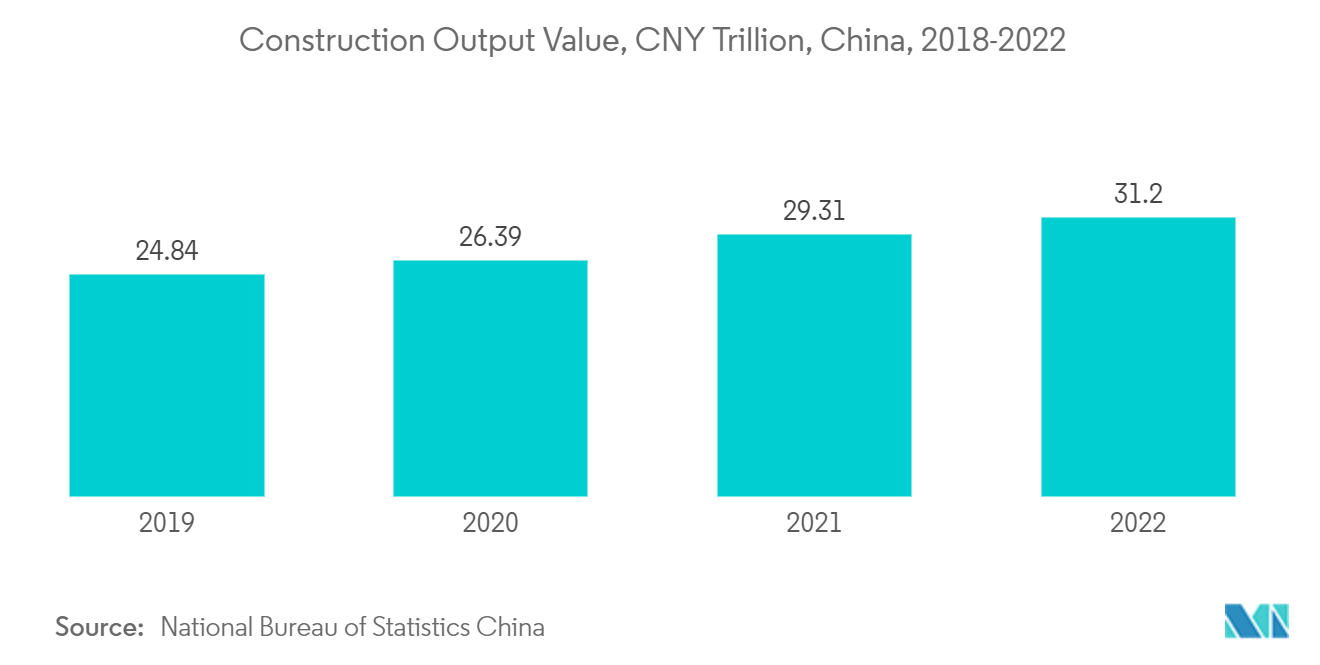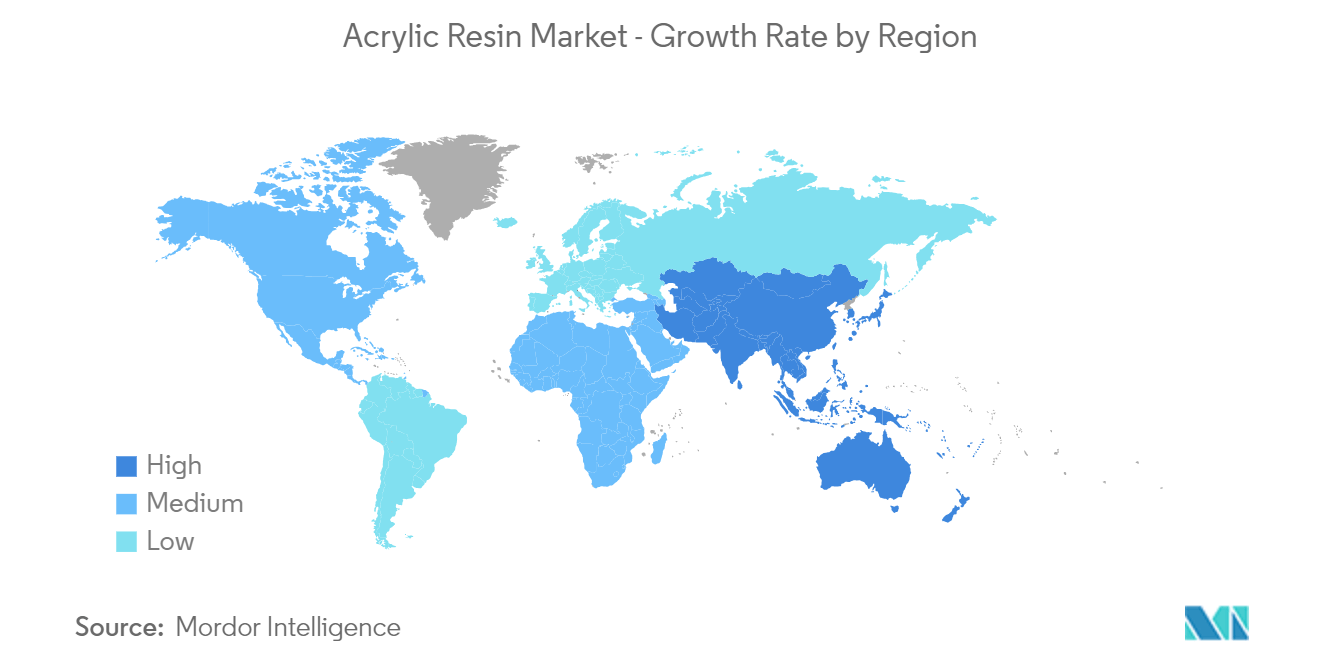Market Trends of Acrylic Resin Industry
Building and Construction Industry to Dominate the End-User Industry Segment
- Acrylic resin is used in building and construction to improve the sustainability, durability, and aesthetics of building materials and for moisture, corrosion, temperature extremes, and weathering resistance of architectural coatings.
- Acrylic resin is also used in paints and coatings applications to provide adhesion over various substrates, superior film resistance properties, flexibility, and durability, and enhance the hiding capacity of paints and coatings.
- The growing infrastructure needs across the globe are adding more value to the acrylic resin market. According to the US Census Bureau, in the past 5 years, from 2018 to 2022, the total value of construction in the United States increased by almost 40%, with residential construction accounting for almost more than a 60% increase in the total value of construction.
- The total value of residential construction in 2022 was USD 927 billion, an increase of 14.6% over 2021. The total value of non-residential construction in 2022 was USD 921 billion, an increase of 9% over 2021.
- According to Eurostat, the annual average production in construction for 2022 increased by 2.6% in the European Union compared with 2021. The highest increase in construction activities was recorded in Slovenia (+74.5%), Romania (+18.4%), and the Netherlands (+4.9%).
- Asia-Pacific is the largest construction market in the world, with India and China leading the way in terms of construction value-added and new projects.
- According to the National Bureau of Statistics China, the value added of construction enterprises in China for 2022 was RMB 8.33 trillion (~USD 1.16 trillion), up by 5.5% over 2021.
- According to Invest India, FDI in the construction (infrastructure) activities in India totaled USD 29.6 billion between April 2000 and March 2023, which accounts for 4.67% of the FDI inflow.
- Looking at the growth in infrastructure in major economies across the globe, the demand for acrylic resin for paints, coatings, adhesives, and sealant applications in the construction industry will likely increase in the forecast period.

Asia-Pacific to Dominate the Market
- Asia-Pacific is the largest market and major demand driver for acrylic resin due to increasing consumption in construction, automobile, and other end-user industries.
- In major economies like China, India, and South Korea, construction is growing rapidly due to urbanization. The countries launched various residential construction projects in recent times.
- The Chinese government is focusing on boosting investments across the construction sector in the country to boost overall economic growth. For instance, according to the National Bureau of Statistics China, recent moves to increase financing for infrastructure construction include a USD 120 billion increase in the lending ratio of policy banks. The government is also considering allowing local governments to spend up to about USD 220 billion of the special bond quota through which local governments fund infrastructure construction.
- According to the Union Budget 2023, the Ministry of Finance, Government of India announced a capital investment of INR 10 Lakh Crore (~USD 120.87 billion) for infrastructure, a 33% increase in capital Investment Outlay. The outlay for PM Awas Yojana increased by 66% to over INR 79,000 crore (~USD 9.54 billion).
- Moreover, under the Urban Infrastructure Development Fund, the government announced an outlay of INR 10,000 crore (~USD 1.2 billion) per year to create urban infrastructure in tier 2 & 3 cities across the country.
- In South Korea, the expansion of smart cities is a major focus area for the country. The Smart City, Solution Expansion Project, is implemented in South Korean cities to improve service conditions and minimize the digital divide by enabling smaller cities with a robust infrastructure. In 2023, a total of 23 local governments applied for the smart city solution expansion project, out of which 8 locations were selected.
- Moreover, the Asia-Pacific region is home to some of the world’s most valuable vehicle manufacturers. Developing countries such as China, India, Japan, and South Korea are working hard to strengthen the manufacturing base and develop efficient supply chains for greater profitability. According to the Organisation Internationale des Constructeurs d’Automobiles(OICA), in 2022, around 50 million vehicles were produced across the Asia-Pacific. It witnessed a growth rate of 7% compared to 46.7 million vehicles in 2021, thereby indicating an increased demand for ultra-high molecular weight polyethylene from the automotive industry. In 2022, around 42 million passenger cars were manufactured in Asia-Pacific, up nearly 11% compared to 2021.
- According to the China Association of Automobile Manufacturers (CAAM), China holds the largest automotive production base in the world, with a total vehicle production of 27 million units in 2022. It registered an increase of 3.4 % compared to 26 million units produced in 2021.
- Furthermore, the demand for electronics products in the Asia-Pacific region mainly comes from China, India, and Japan. As per the Japan Electronics and Information Technology Industries Association (JEITA), the Asia Pacific production by Japanese Electronics and IT Companies is likely to reach JPY 40,759.9 billion (~USD 312.15 billion) by the end of 2023, witnessing a growth rate of 3% year-on-year.
- The demand for acrylic resin is expected to grow significantly for the studied market by looking at the positive growth trends in the major end-user industry segments.


